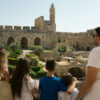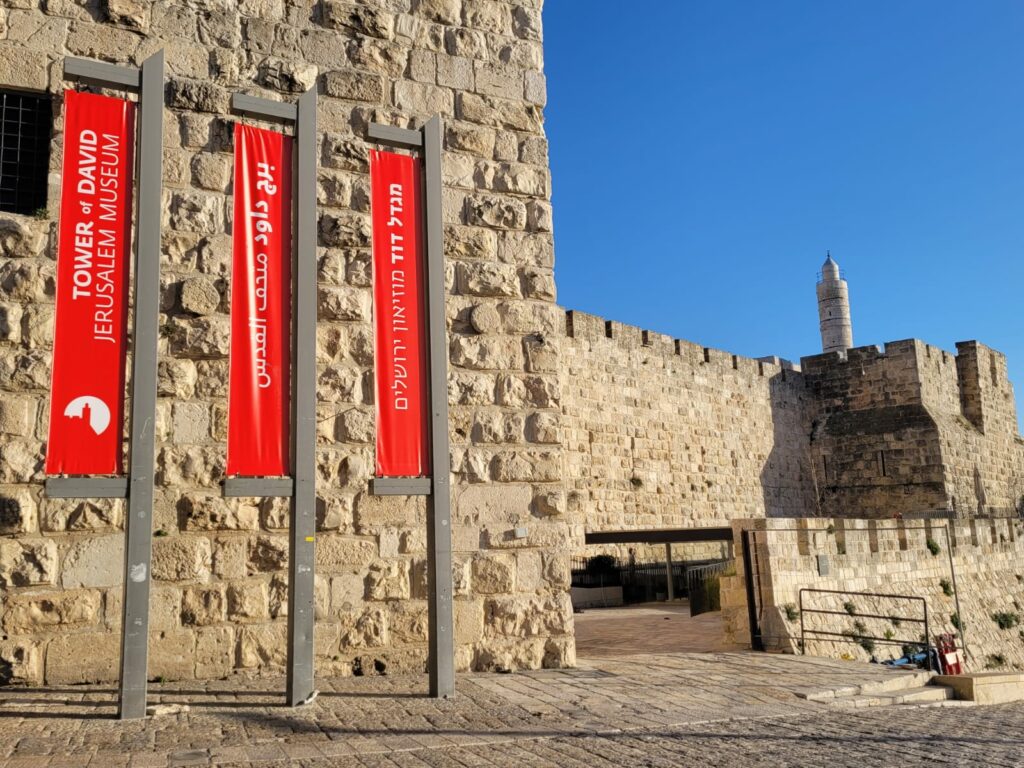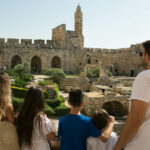
Visiting the Tower of David Jerusalem Museum
New Permanent Exhibit, Innovative Galleries, Exciting Archaeological Finds
Welcome to the New Tower of David Jerusalem Museum, located in one of the most important and exciting historical sites in Israel – the Citadel of Jerusalem. On June 1, 2023 we reopened our gates after an extensive renewal and the creation of a new permanent exhibition spanning 10 galleries and combining innovative technology, interactive presentations, archaeological finds and ancient artifacts.
A ticket to the museum includes:
A visit to the new permanent exhibition of the museum, guided tours in the museum, entrance to the moat, ascent to the observation point on top of Phasael Tower, a 360° view over Jerusalem, and wandering the courtyard of the Citadel.
Note: the new Museum entrance is located to the right of the courtyard at the exit from Mamilla Rd. Look for the 3 red flags with the Museum name.
For Guided Tours, Click Here >>
Renewal at the Museum
In June 2023, we opened our gates to the general public as the renewed Tower of David Jerusalem Museum, upon completion of a renovation and renewal project costing more than $50 million with the major support of the Clore Israel Foundation, and the participation of Keren Hayesod, the Jerusalem Municipality, the Ministry of Jerusalem and Heritage, and the Ministry of Tourism.
The renovation included conserving the ancient fortress, renovating the minaret, renewing the archaeological park, constructing a new entrance pavilion with a museum store and cafe, upgrading infrastructure, conducting additional archaeological excavations, and improving accessibility at the citadel. Additionally, a new permanent exhibit was installed with 10 galleries combining innovative technology, interactive displays, archaeological artifacts and ancient objects.
New Entrance Pavilion
The new entrance to the museum, currently under construction on the western side of the citadel, is situated next to Jaffa Gate. Thus, the visitors’ path in the museum starts in the West, serving as an entrance to understanding the city and its story, and finishes with an exit to the Old City through the citadel’s original entrance gate in the East. (Night Experiences, however, will continue to have their entrance in the East.)
The improved entrance complex includes a ticket booth and a cafe, creating a new, wide public space, and allowing access directly to Jaffa Gate and Mamilla Street. It can be utilized as a pleasant, shaded break before entering the Old City for groups, tourists and vacationers.
New permanent exhibit
In the new permanent exhibit at the Tower of David Jerusalem Museum, visitors embark on a journey to the center of the world, to the city holy to 3 religions: Judaism, Christianity and Islam. The 10 galleries of the exhibit, combine archaeological finds and ancient objects together with innovative interactive displays, video-art installations, and films produced especially for the exhibit.
In the new permanent exhibit, discover the city that large empires from west and east fought over for almost 4,000 years; become familiar with physical Jerusalem and the Jerusalem representing the eternal connection between God and man; celebrate Jerusalem as a meeting place between religions and cultures through the yearly holiday cycle of 3 religions in a unique animated theater presentation by illustrator David Polonsky; gaze over the city from a birds’ eye view in a stunning model from the 19th century; illuminate the moment in time when the city broke out of its walls; and discover the story of the Tower of David citadel as a symbol of the microcosmos of the city’s past and present through the collection of items that were found in the citadel, and posters and postcards which were inspired by it. Two galleries for temporary exhibits for current topics complete the picture. Through it all, the story of Jerusalem is spread out in front of the visitor as a rich, varied experience. Many important designers participated in this joint creative project, including the director and producer Ari Folman, who produced the opening film presentation in the museum’s new permanent exhibit.
Accessibility for One and All
We believe that everyone has the right to enjoy a visit to the museum as equals, and strive to promote accessibility to the greatest degree possible. Despite the challenging physical makeup of the museum, located in an ancient citadel with remains from different archaeological periods, we took up the banner to create accessible programs and projects held here.
During recent years, we have conducted tours for the blind and sight impaired, founded an enrichment course for training guides for people with low cognitive function, made accessible the Night Experiences for people who are blind and sight impaired through audio description and cordless headphones, held fun activities for special-needs families and adults, and initiated monthly relaxed performances of the Night Experiences that are accessible for adults and children with special needs. Additionally, we established the Jerusalem Forum for Accessibility and Inclusion in Museums, which under the Israel Council of Museums, has become a nationwide forum. Soon, additional accessibility will be initiated such as making the Night Experiences accessible to hearing impaired, a sensory map, and tours conducted outside of the confines of the Citadel offered for those using wheelchairs.
The Observation Point from Phasael Tower is not physically accessible because of concerns surrounding preservation of the tower. Despite this, we have done everything possible to increase accessibility, and visitors with limited mobility can enjoy and examine the observation point through VR glasses or 360° photography. In the future, we will offer 2 additional channels for the museum’s audio guide: a channel with audio description for blind and sight impaired, and a “visual guide” in Israeli and international sign language for the deaf.
Selected activities (not included in Museum entrance fee):
Marvelous Night Experiences screened on the ancient walls
Sound and light shows revealing the story of Jerusalem through powerful sounds and images screened on the walls of the Citadel. The performances are for speakers of all languages, accessible to people with limited mobility, and are shown in the open air under the stars. The performances are about 40 minutes long. For additional information >>
Combination ticket for Yalla Basta and a visit to the Tower of David Jerusalem Museum
Entrance ticket for the Tower of David Jerusalem Museum combined with a tasting card from Yalla Basta. Receive coupons and a map of the central market, allowing you to independently wander its streets. With the tasting card you can receive tastings from our carefully chosen market vendors and enjoy a culinary experience in one of the most beloved markets in Israel. For additional details >>
*Recommended to purchase tickets online before you arrive at the Museum.
| Adults | Senior* | Students | Child* | Disabled | Soldiers* | |
|---|---|---|---|---|---|---|
| Museum Admission | 50 ₪ | 25 ₪ | 40 ₪ | 25 ₪ | 25 ₪ | 25 ₪ |
| Night Experiences Night Spectacular / KING DAVID | 67 ₪ | 62 ₪ | 62 ₪ | 57 ₪ | 42 ₪ | 42 ₪ |
| Combination Ticket 1 Museum Admission + Night Experiences Night Spectacular/KING DAVID | 102 ₪ | 80 ₪ | 90 ₪ | 75 ₪ | 60 ₪ | 60 ₪ |
| Combination Ticket 2 | Starting March 17 Museum Admission + Ramparts Walk | 60 ₪ | – | – | 30 ₪ | – | – |
|
||||||
FAQ
-
The Tower of David Museum is an historic site without parallel in Jerusalem or, indeed, the entire world. The Museum is located within the Tower of David Citadel, the iconic symbol of Jerusalem, and tells Jerusalem’s 3,000 year old story through innovative, exciting technology. The Citadel is located at the meeting point between East and West Jerusalem and expresses the continuing dialog that exists between ancient and modern-day Jerusalem. The Tower of David rises above the walls of the Old City, and can be seen from afar. It welcomes all those who come to the Old City through the main gate, Jaffa Gate.
-
The site is called “Tower of David” because of a mistaken reading of Josephus Flavius during the Byzantine Period. The blunder continued with the Moslem designation of the Citadel as the “Michrab (prayer niche) of the Prophet David”. As years passed, visitors from Western countries transferred the misnomer to the minaret of the Turkish mosque, and the name stuck. Many places in Jerusalem are named after King David; we at the Citadel also pay homage to the city’s legendary monarch.
-
The Tower of David is located on the spot that has guarded Jerusalem for thousands of years; rulers throughout history have left their mark here. King Herod built 3 massive towers here and the largest one, the Phasael Tower, is still standing. During the Early Muslim Period, the Citadel was built, the remains of which can be seen today in the center of the courtyard – a round tower 10 meters/30 feet in diameter. The Crusaders constructed a royal palace here; they added a beautiful entrance and a moat (dry and without alligators!). The Mamelukes strengthened the walls of the Citadel and added sophisticated, advanced architectural elements to make the Citadel a symbol of strength. Among the impressive extensions built by the Mamelukes is the hexagonal tower appended to the Phasael Tower. The Ottomans built a monumental entrance gate at the Museum’s eastern entrance, a beautiful stone bridge, the open mosque, and the cannon yard. Their most striking addition was the minaret, the tower of the mosque, known today as the Tower of David, a prominent symbol of the city of Jerusalem. The British converted the Citadel’s rooms into exhibition spaces; they actually were the first to use the Tower of David not for defense and protection but rather for peace – as an exhibit space for art and cultural events. After the War of Independence in 1948 the Jordanian Legion controlled the citadel and it became a fortress once again. After the 1967 Six Day War, the Citadel came under Israeli sovereignty and in 1989 the Tower of David Museum was opened. From then until now, the archaeological courtyard has hosted visitors from all over the world who come to discover the story of Jerusalem. So actually, everyone contributed to building this place, and all are welcome to enter it! The courtyard of the Citadel is extensive and there are many shady and grassy areas to relax in – come tour the citadel through its exciting history or just to enjoy a picnic in the pleasant hours of the afternoon, all in the shadow of a Second Temple Period tower or a Byzantine water cistern.
-
Yes! Kids love wandering the walls of the Citadel, peeking out through the arrow slits, and climbing on the towers. Also, our Night Experiences are recommended for children ages 3 and up. Check our website for special events that we offer kids throughout the year.
-
Paid parking is available in the Karta and Mamilla lots across the street.
-
The new entrance to the Museum is located to the right of the Jaffa Gate courtyard when exiting Mamilla Rd. Look for the 3 red flags with the Museum name.
-
The Citadel is an archaeological site which, for thousands of years, served as a fortress to protect the residents from attack, and so was designed from the beginning as an inaccessible site. However, the Tower of David Museum has dedicated much attention to making the site and parts of the visitors’ paths accessible. The two Night Experiences are accessible to people with limited mobility. We recommend contacting the reservation center in advance to arrange access. The Night Spectacular is accessible to blind and sight-impaired people through verbal description. To arrange for this, call the reservation center at *2884.
-
Of course! The Museum cooperates with all the large customer clubs where you can find discounts on tickets for the Museum, the Night Experiences and special events. In addition, those staying in Jerusalem hotels are entitled to a 15% discount on entrance to the Museum / Night Experiences upon presentation of our coupon, found at your hotel.
-
Entrance fee for the Museum: Adult – 50 NIS Child (5-18) – 25 NIS | Israeli Senior Citizen – 25 NIS | Student 40 NIS Ticket to the Night Experiences: Adult – 67 NIS | Child (3-18) – 57 NIS | Israeli Senior Citizen / Student – 62 NIS Combined ticket to the Museum and the Night Experience: Adult – 102 NIS | Child (5-18) – 75 NIS | Israeli Senior Citizen – 80 NIS | Student – 90 NIS
-
The Night Spectacular presents the story and faces of Jerusalem woven through a powerful, multi-sensory, multi-media presentation. This sound and light show carries the viewer back in time through the history and events that created Jerusalem. KING DAVID tells the life story of the boy, David, who became king and one of the most famous leaders in the history of the world. The sound and life show brings his character to life as it is screened on the ancient walls between the remains of different historical periods. The story of King David is projected on the stones of Jerusalem, the city he founded and which he built thousands of years ago.
-
There is open seating and there are enough seats for all. You can see the presentation in its entirety from every seat in the theater.









